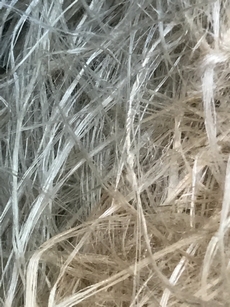終了いたしました
高宮布と言えば今では麻に関心のある人は聞いたことのある名前になりましたが
具体的にどのような布なの?とよく聞かれます。
高宮布とは、室町時代から江戸時代に、近江 (現在の滋賀県)の犬上郡、愛知郡、神崎郡などで生産されて琵琶湖の東に位置する高宮と言う地から出荷された大麻と苧麻を使った麻布の事を言います。
高宮(現在滋賀県彦根市高宮町 )は古くから中山道の宿場町で、これらの湖東周辺で生産された麻の反物がこの地に集められてそこから出荷されたためにその名前がつきました。
江戸時代初期には彦根藩の献上品として用いられるなどその品質は確かなものとして知られていました。庶民にも親しまれて各地に流通していました。
しかしながら文献には名前が出てくるのですが、その麻布とはどのようなものか長い間わからないままでした。

近世麻布研究所の吉田真一郎氏が、その当時、古布を知る人々が当然のように奈良縞や、越後縮(えちごちじみ)とか沖縄の麻布と言っていた絣と縞、格子を駆使した洒落た江戸時代、明治初期の着物に注目し、氏自身の膨大な資料を基に繊維検査をされたところたて糸よこ糸共に大麻が使用されていたり、たて糸が大麻でよこ糸が苧麻、或いは絣糸や縞糸が苧麻で地糸が大麻など、巧みに組み合わされた麻織物であることがわかりました。
奈良縞も越後縮も沖縄の布も苧麻だけで織られていましたので、大麻の糸を用いた着物はどこで作られたのか?
その頃滋賀県東近江市能登川博物館で文政2年の年号のある奈良縞や越後縮や沖縄の麻布とよく似た麻布が貼られた縞帖が見つかり、吉田氏が繊維検査を行った結果、大麻と苧麻が検出されました。
この調査で長い間分からなかった前述の着物は高宮布であることがはっきりしました。
2007年には先の東近江市能登川博物館と愛荘町立歴史文化博物館で吉田氏の研究を元に高宮布の実像に迫る展覧展が開かれました。
発表された麻布は、越後上布や沖縄の麻布のように糸が細くて優雅な風情ではなく少々粗く硬質な感じですが、着物の柄という概念を超えた現代的な雰囲気のある洗練された麻布です。
高宮布では地糸に大麻をよく使っていました。
苧麻は単繊維が長く糸の段階で晒してもバラけて弱くなりにくいので白く晒せます。
絣の部分は白色と藍色の違いを際立たせる為にあくまで糸を真っ白にしたいとの理由から、高宮布では苧麻を使用したものが多くあります。
その結果 たて糸やよこ糸の地糸が大麻、たて糸よこ糸の絣糸や縞糸が苧麻などという複雑な布が誕生しました。
この様な驚くほど細やかな作業には織り手と同時に傍にアートディレクターの様な存在がいたのではないかと推測されてもおかしくない仕上がりの布です。
中には、たてとよこの地糸が苧麻で絣糸の苧麻糸の中にたった2本だけ大麻を織り込むという不思議な布もあります。大麻は古代から神聖な素材でしたので、何か呪術的な意味があったのではないか?など想像をかき立てられます。
明治時代になり、近江はいち早く手績み糸を残しながらも徐々に紡績糸に切り替わり近代化へと進んでいきました。それは同時に江戸時代、明治半ば頃までに作られていた大麻と苧麻にこだわった特徴的な文様の麻布から離れていく事にもなり、次第に”高宮布”の実像が冒頭でも述べました様に分からなくなっていきました。
ギャラリー啓があたためておりました高宮布をギャラリー啓の言葉でご紹介する展覧会をしたいと思いたってから、長くかかりましたが、ようやく皆様にご紹介できる事になりました。
それはまさにギャラリー啓が品揃えのときに心がけている" 時代も国境も超える" をそのまま映し出したような麻布です。

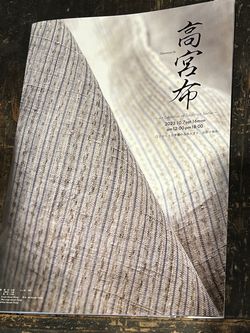
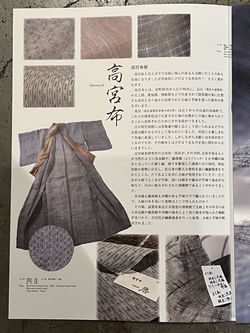
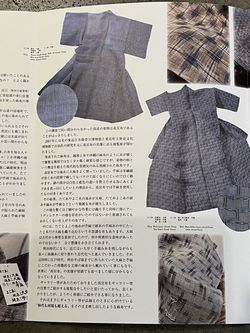
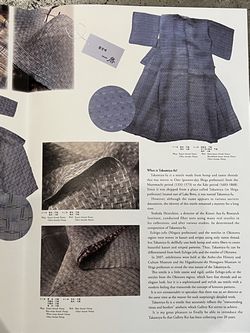
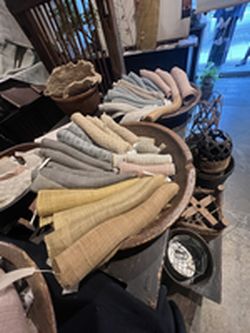

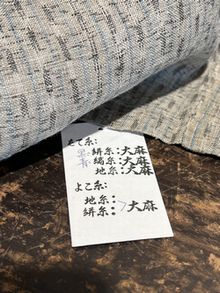

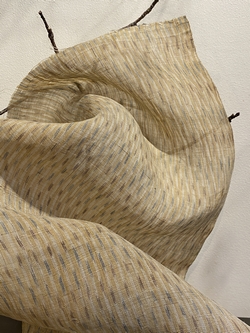

たて糸 絣糸:苧麻
よこ糸 絣糸が地 糸:苧麻
黒縞糸:大麻
青縞糸:大麻
地糸:大麻
Warp Kasuri thread: Ramie
Weft All kasuri
threads: Ramie
Black stripe thread: Hemp
Blue stripe thread: Hemp
Other threads: Hemp
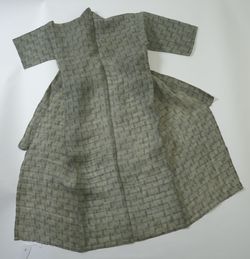
An Ehibition of
Takamiya-fu
What is Takamiya-fu?
Takamiya-fu is a textile made
from hemp and ramie threads that was woven in Omi (present-day Shiga
Prefecture) from the Muromachi period (1333-1573) to the Edo
period (1603-1868).
Since it was shipped from a
place called Takamiya(Shiga prefecture) located east of Lake
Biwa., it was named Takamiya-fu.
However
though the name appears in various ancient documents, the identity of
this textile remained a mystery for a long time.
Yoshida Shinichiro who is a
director of the Kinsei Asa-fu Research Institute, conducted
fiber tests using many real textiles in his collections , and after
various studies, he clarified the real image of Takamiya-fu.
In 2007, exhibitions were held
at the Aisho cho History and Culture
Museum and the Higashioumi-shi Notogawa
Museum in Shiga prefecture to uncover the real image of the
Takamiya-fu.
Echigo-jofu
(Niigata Prefecture) and the textiles in Okinawa region were woven
Kasuri and stripe only with using
ramie thread, but
Takamiya-fu skillfully uses both hemp and ramie fibers to create
beautiful kasuri and striped patterns. This led to the
clarification of Takamiya-fu.

This textile is a little
coarse and rigid, not like Echigo-Jofu or the textile from
Okinawa Region that are
fine threads and elegant look, but it is a sophisticated and stylish
asa textile with a modern atmosphere that transcends the
concept of kimono patterns.
It is not unreasonable to
speculate that there was an art director at the same time as the
weaver for such surprisingly detailed work.
The Takamiya-fu is
exactly the textile reflects the "transcending times and borders" as
the same time Gallery Kei strive achieve
It’s my pleasure very much to
finally be able to introduce the Takamiya-fu that Gallery Kei has been
collecting for a long time.
Note
Kinsei: Early modern times
Azuch-Momoyama period to Edo period 1568-1867)



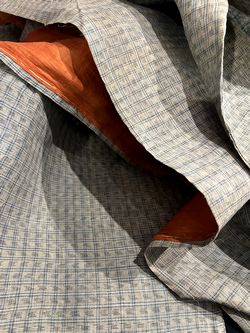

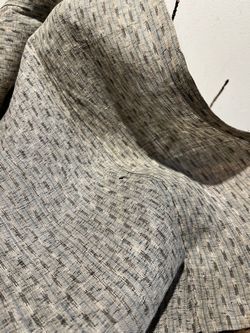

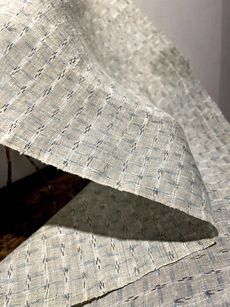
<取り扱い品目>
| 木綿以前の、草や木から作られた布や庶民の仕事着− 藤布、芭蕉布、葛布、科布、オヒョウ(アイヌ) 対馬麻(大麻) 越後上布、近江上布等の苧麻布 など- | |
| 麻、木綿の刺子(さしこ)や裂織(さきおり)の着物、仕事着 | |
| 一巾から端ギレまで しな布・籐布・紙布・葛布・芭蕉布・対馬麻・東北地方の麻のカヤ地 苧麻布糸味のいい木綿 光沢の有る絹織物。 | |
| 時代ー江戸末 明治、大正、和初期ごろまで | |
| 仕覆に合う布 − 丹波布、丹波木綿、黄八丈、縞物、 インド更紗 和更紗など。 | |
| 古民具・古民芸 箪笥、人形、灯火器、カゴちょっとヘンなもの。 |
|
| やきもの 伊万里、美濃、瀬戸など |
|
| オリジナル着物−70〜80年前の結城紬や久米島紬、宮古、越後上布などを、仕立て直した着物や帯。
|
Gallery Kei deals in;
| Kimono or work garments woven from bast fiver - Wisteria(, Fuji-fu ) Elm( Ohyo), Linden( Shina-fu ), Paper mulberry ( Shi-fu ), Kudzu( Kuzu ), Banana fiber( Basho-fu ) Hemp( Taima ), Ramie( choma )・・・・ | |
| Stitched with hand spun cotton(Sashiko ) or woven with recycled Kimono as weft thread (Sakiori ) work garments | |
| Fragments made from various textiles in the above materials | |
| Cotton and quality silk pieces of Tamba,Kihachijo, Sarasa etc. | |
There is also cloth suitable Shifuku. −Shifuku=The bag into which the tea caddy of powdered green tea is put.− |
|
| Old folk arts and crafts, daily tools--- chest of drawers,dolls,lamps,baskets etc. | |
| Pottery---Imari,Mino,Seto etc. |
|

おおつずれ
たて::藤糸
藤の糸に左の紙の糸を巻きつけてよこ糸に

Otsuzure
warp thread : wisteria thread
weft thread : wisteria thread wrapped with recycled paper

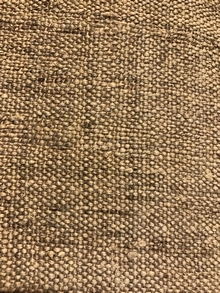
藤布 a woody climbing vine of wisteria group

Item No40

藤布
Fuji Fu Wisteria thread
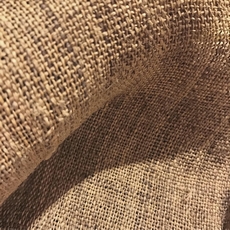

苧麻か大麻 Hemp or Ramie

